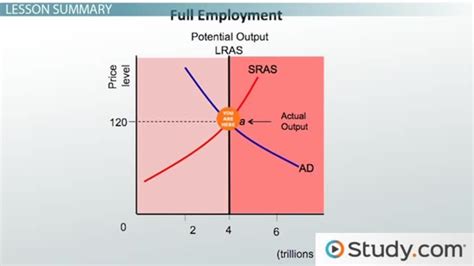Introduction

Full employment output is the maximum amount of goods and services that an economy can produce when all its available labor resources are fully utilized. Achieving full employment is a crucial goal for any economy, as it brings numerous benefits and fosters economic prosperity.
Economic Benefits of Full Employment
- Increased Productivity: When all labor resources are employed, businesses have access to a larger pool of skilled workers, leading to increased productivity and innovation.
- Higher Wages: Increased demand for labor in a full employment economy drives up wages, improving the financial well-being of workers.
- Reduced Inflation: With more people working, businesses are less likely to raise prices to cover production costs, minimizing inflationary pressures.
- Economic Stability: A full employment economy is less susceptible to economic fluctuations and recessions, providing stability to businesses and consumers.
Macroeconomic Indicators of Full Employment
According to the Bureau of Labor Statistics (BLS), the following indicators suggest a full employment economy:
| Indicator | Benchmark |
|---|---|
| Unemployment Rate | 4-5% |
| Labor Force Participation Rate | 63-64% |
| Employment-to-Population Ratio | 60-61% |
Challenges to Achieving Full Employment
- Technological Advancements: Automation and technological advancements can displace jobs, making it challenging to maintain full employment.
- Economic Fluctuations: Recessions and economic downturns can lead to job losses and higher unemployment.
- Labor Market Inefficiencies: Skills mismatches, lack of job training, and geographical barriers can hinder full employment.
Strategies for Promoting Full Employment
- Fiscal Policy: Governments can implement fiscal policies such as tax cuts and increased spending to stimulate economic growth and job creation.
- Monetary Policy: Central banks can adjust interest rates to influence the supply of money and encourage borrowing and investment.
- Labor Market Policies: Governments can enhance labor market efficiency through job training programs, apprenticeship schemes, and policies to reduce barriers to employment.
Innovative Applications for Full Employment
Ideaphoria: A collaborative platform where individuals can share and develop ideas for new products and services that create employment opportunities.
Co-Working Spaces and Incubators: Provide affordable workspaces and support for entrepreneurs and small businesses, fostering job creation and innovation.
Remote Work Technologies: Enhance work-life balance and accessibility, allowing more people to participate in the labor force.
Common Mistakes to Avoid
- Overheating the Economy: Aggressive monetary and fiscal policies can lead to inflation and economic imbalances.
- Ignoring Structural Issues: Focusing solely on job creation without addressing underlying labor market inefficiencies can hinder long-term full employment.
- Neglecting the Role of the Private Sector: Government policies should encourage private sector investment and job creation.
Conclusion
Full employment output is an essential component of economic prosperity. By implementing sound economic policies and addressing labor market inefficiencies, policymakers can promote full employment, maximizing economic growth, improving living standards, and ensuring a more stable and equitable society.
